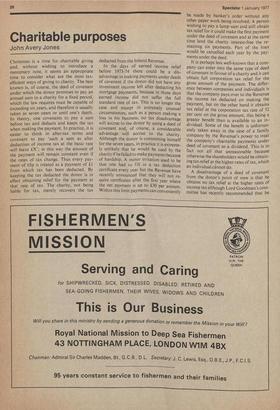Charitable purposes
John Avery Jones
Christmas is a time for charitable giving and, without wishing to introduce a mercenary note, it seems an appropriate time to consider what are the most taxefficient ways of giving to charity. The best known is, of course, the deed of covenant under which the donor promises to pay an annual sum to a charity for a fixed period, which the law requires must be capable of exceeding six years, and therefore is usually taken as seven years or until one's death. In theory, one covenants to pay a sum before tax and deducts and keeps the tax when making the payment. In practice, it is easier to think in after-tax terms and covenant to pay 'such a sum as after deduction of income tax at the basic rate will leave EX': in this way the amount of the payment will remain constant even if the rates of tax change. Thus every payment of 65p is treated as a payment of £1 from which tax has been deducted. By keeping the tax deducted the donor is in effect obtaining relief for the payment at that rate of tax. The charity, not being liable for tax, merely recovers the tax deducted from the Inland Revenue.
In the days of earned income relief before 1973-74 there could be a disadvantage in making payments under deeds of covenant if the donor did not have any investment income left after deducting his mortgage payments, because in those days earned income did not suffer the full standard rate of tax. This is no longer the case and except in extremely unusual circumstances, such as a person making a loss in his business, no tax disadvantage will accrue to the donor by using a deed of covenant and, of course, a considerable advantage will accrue to the charity. Although the donor is committing himself for the seven years, in practice it is extremely unlikely that he would be sued by the charity if he failed to make payments because of hardship. A minor irritation used to be that one had to fill in a tax deduction certificate every year but the Revenue have recently announced that they will not require certificates after the first year where the net payment is up to £30 per annum. Within this limit payments can conveniently be made by banker's order without any other paper work being involved. A person wishing to pay a lump sum and still obtain tax relief for it could make the first payment under the deed of covenant and at the same • time lend the charity interest-free the remaining six payments. Part of the loan would be cancelled each year by the payments under the deed.
It is perhaps less well-known that a company can enter into the same type of deed of covenant in favour of a charity and it can obtain full corporation tax relief for the gross amount of the payment. The difference between companies and individuals Is that the company pays over to the Revenue the income tax deducted on making the payment, but on the other hand it obtains tax relief at the corporation tax rate of 52 per cent on the gross amount, this being a greater benefit than is available to an individual. Some of the benefit is unfortunately taken away in the case of a family company by the Revenue's power to treat the company's charitable payments under deed of covenant as a dividend. This is in fact not all that unreasonable because otherwise the shareholders would be obtaining tax relief at the higher rates of tax, which an individual cannot do.
A disadvantage of a deed of covenant from the donor's point of view is that he obtains no tax relief at the higher rates of income tax although Lord Goodman's committee has recently recommended that he






















































 Previous page
Previous page